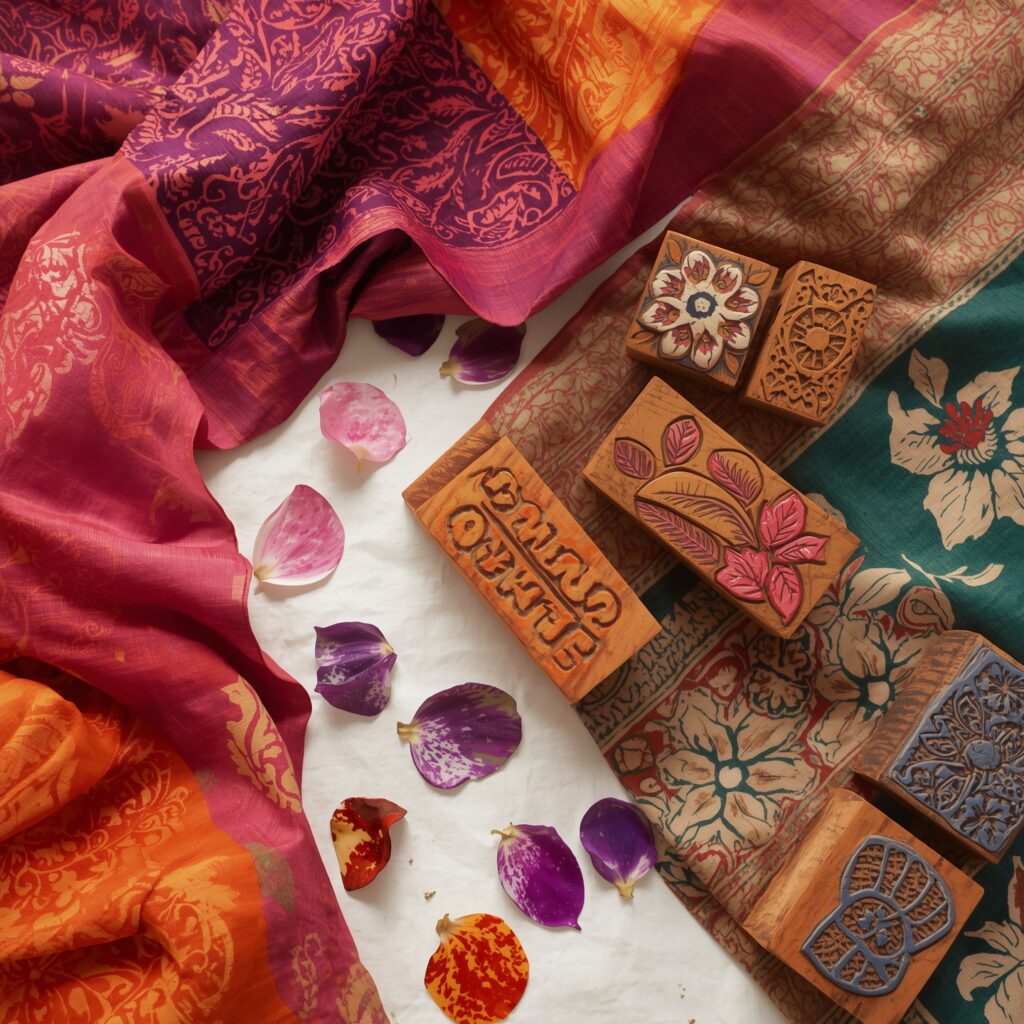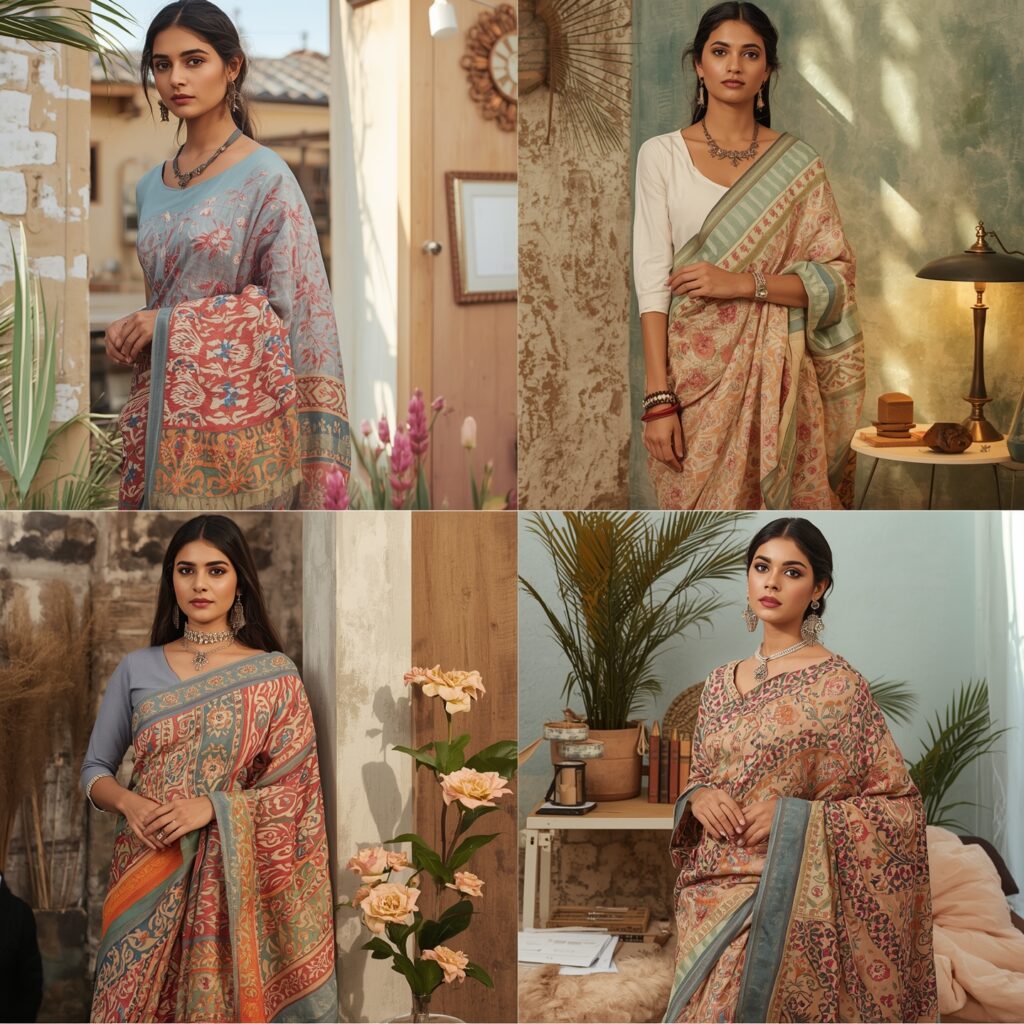Sarees have always been an epitome of grace, beauty, and cultural dignity in India. Of all the varieties of sarees, the block print saree is an exemplar of traditional art and artistic genius. Famed for its intricate patterns, wooden blocks hand-carved, and natural dyes, block print sarees are not only clothes but ageless tales inscribed in fabric. This centuries-old craft, which has been around since centuries ago, is still very much alive as one of the most precious handloom methods in fashion.
Thank you for reading this post, don't forget to subscribe!What is a Block Print Saree?
A block print saree is a manually printed fabric developed through the usage of wooden blocks carved with intricate designs, motifs, or patterns. These blocks are dipped in natural or synthetic dyes and then pressed gently onto fabric, producing symmetrical and repetitive patterns. The whole process is manual and demands skill, patience, and artistry.
Unlike machine prints, each block-printed saree has slight differences, and each is unique. The little imperfections are revered as part of its originality and beauty.
History of Block Printing in India
Block printing is the oldest method of printing in the world, and India has been its centre for more than 2,000 years. According to ancient history, block printing was first introduced in Rajasthan and Gujarat, where artists developed the art using natural colorants and patterns based on nature, animals, and everyday life.

During the Mughal period, the art form thrived as royal patrons urged artists to experiment with ornate designs. The Persian and Mughal influence can still be witnessed in the flower and paisley design commonly utilized in block print sarees today.
Block printing gradually reached various parts of the country, each acquiring its own unique identity. From Rajasthan’s Bagru and Sanganeri prints to Gujarat’s Ajrakh prints and Andhra Pradesh’s Kalamkari, every style has cultural richness and regional flavor.
Making of Block Print Sarees
The creation of a block print saree is a time-consuming process that comprises multiple steps:
Design Carving – Designs are carved on wooden blocks by trained craftsmen, usually from teak or sheesham wood. A block would depict one motif or a section of a larger design.
Fabric Preparation – Cotton, silk, or linen cloth is washed and conditioned to get rid of starch so that it absorbs the dyes smoothly.
Dye Mixing – In the past, natural dyes from plants, minerals, and herbs were used. Now, environmentally friendly dyes are used to maintain the originality of the craft.
Printing Process – The wood block is immersed in the color and applied with carefulness to the fabric. Various blocks and hues are applied depending on the intricacy of the pattern.
Drying and Finishing – The saree is dried in the sun after printing and washed multiple times to set the colors permanently.
This labor-intensive process makes every saree not only cloth but art.
Popular Trends in Block Print Sarees
Block print sarees have different regional patterns, each with its own story:
Bagru Print – Renowned for natural colors, geometric patterns, and nature dyes, from Rajasthan.
Sanganeri Print – Delicate floral motifs in soft pastel colors, rendering the sarees a subtle, sophisticated charm.

Ajrakh Print – Intricate geometric and floral motifs in indigo and madder red, typically standing for cosmic motifs.
Kalamkari Block Prints – Mythological motifs and narration with intricate hand-carved blocks in Andhra Pradesh.
Why Block Print Sarees Are Special
Eco-Friendly Fashion – As block printing conventionally employs natural dyes and manual operations, it supports eco-friendly fashion.
Unique Artistry – No two block-printed sarees are ever the same, thus making them unique.
Versatility – For casual wear and festivals as well, block print sarees look great with contemporary or traditional accessories.
Cultural Heritage – Wearing a block print saree is akin to carrying centuries of Indian art and tradition.
Styling Tips for Block Print Sarees

Wear a cotton block print saree with oxidized silver jewelry for an ethnic, rustic look.
For work attire, use light pastel prints with a simple blouse for an understated yet classy look.
For festival wear, use silk block print sarees with zari borders, accompanied by show-stopping jewelry.
Play around with trendy blouses or crop tops to provide a modern touch to your saree.
Block Print Sarees in Modern Fashion

Block print sarees are not confined to traditional wardrobes anymore. Celebrities’ red-carpet sightings and sustainable fashion trends are witnessing this ancient art being used with modern designs. Block print sarees are now a symbol of green glamour.
Their international popularity has also been boosted with exports finding their way to countries such as Europe, the US, and Japan. The beauty of handmade fabric speaks to individuals who prefer uniqueness to mass-produced products.
Taking Care of a Block Print Saree
As block print sarees are delicate, they need to be handled with care:
Gently wash them in cold water using mild detergent.
Don’t expose them to direct harsh sunlight for extended periods of time to avoid fading of colors.
Keep them in a dry and cool place covered in cotton cloth.
Final Thoughts
Block print saree is not just clothing but an ode to the artistic culture of India. From its glorious past to its green process and international appeal, it is a culmination of traditional values and contemporary style. Whether on a wedding day, a festival, or a day out, a block print saree never fails to look everlastingly elegant.
Buying one is not merely about style—it’s about respecting centuries of tradition and keeping an art form alive that should continue to flourish for centuries to come.


